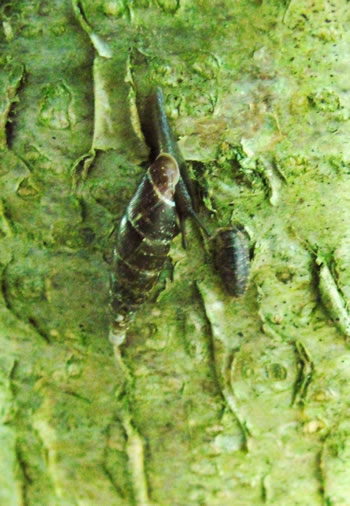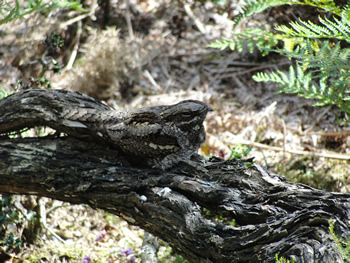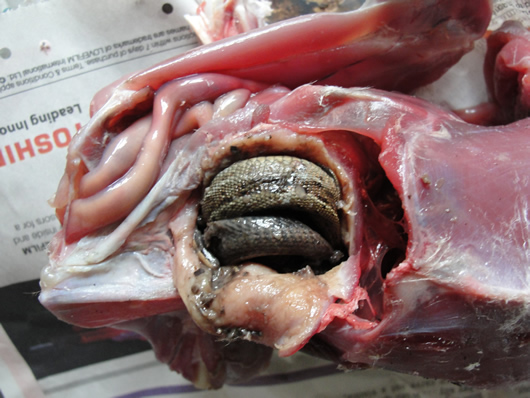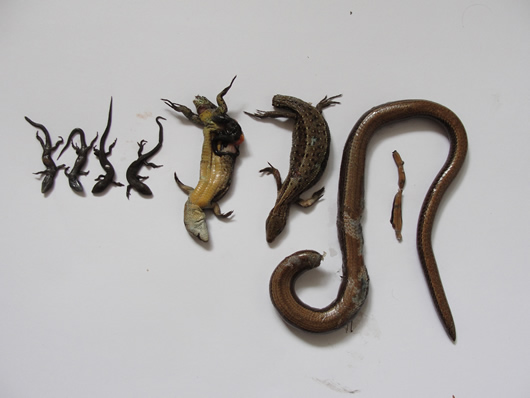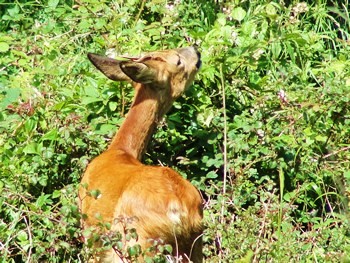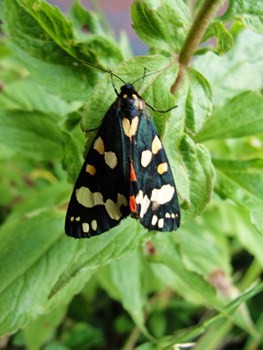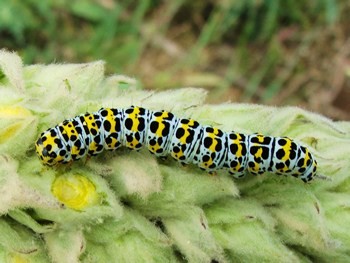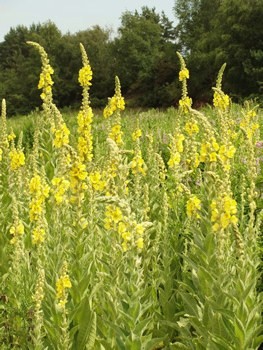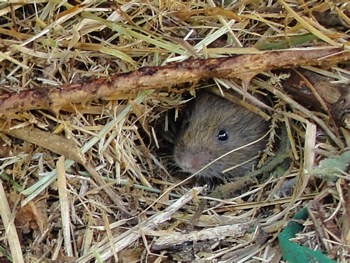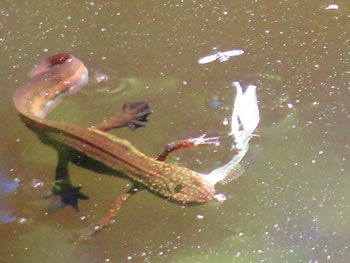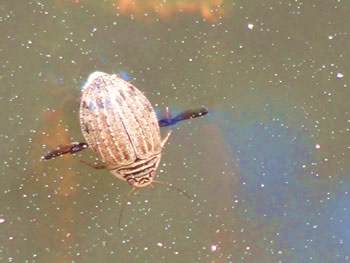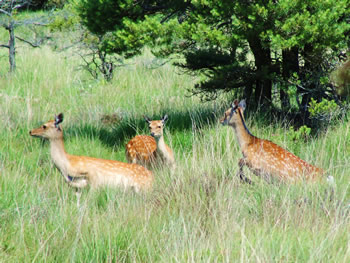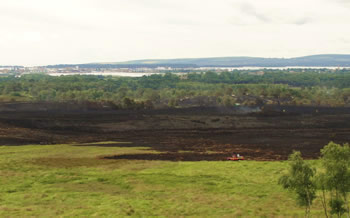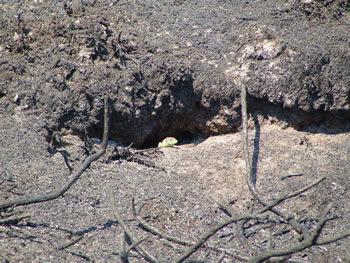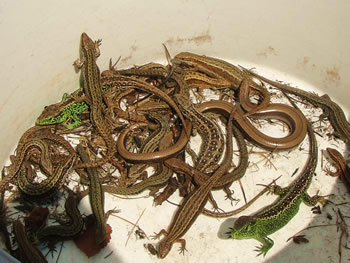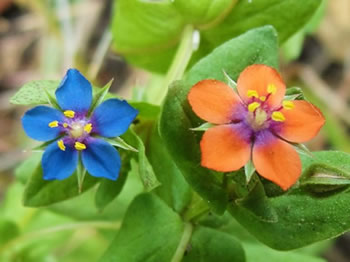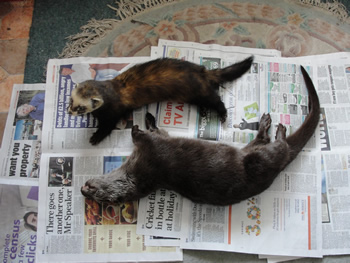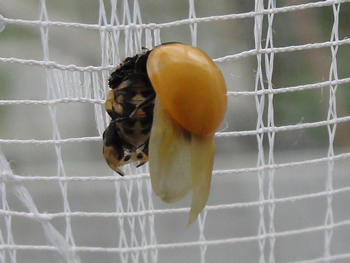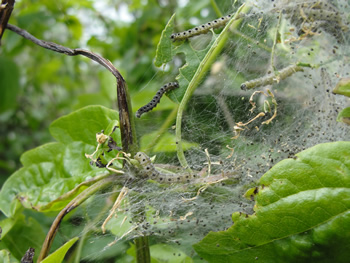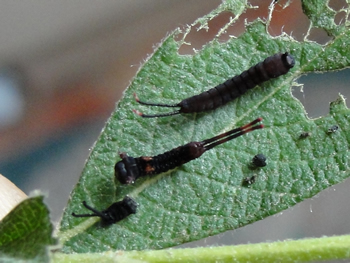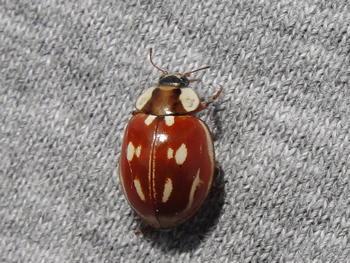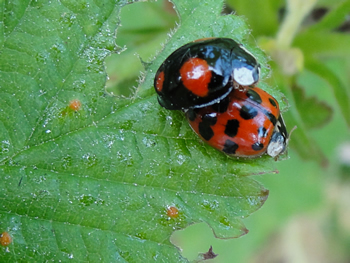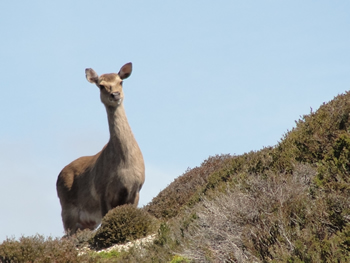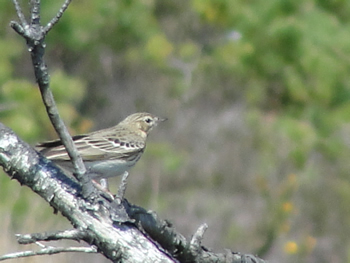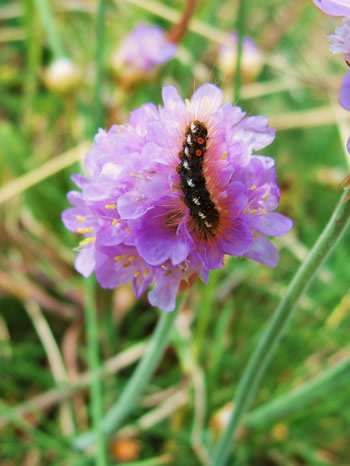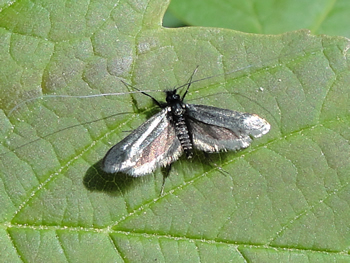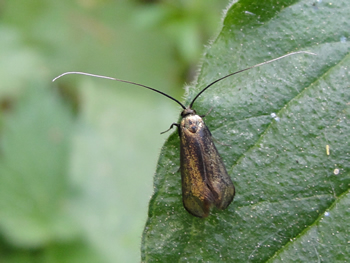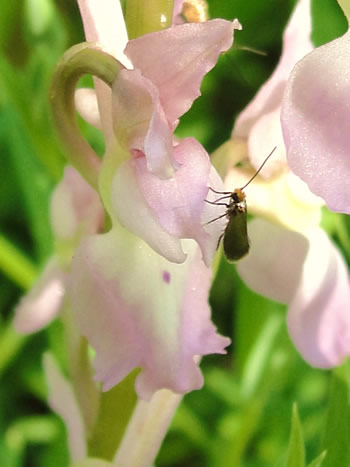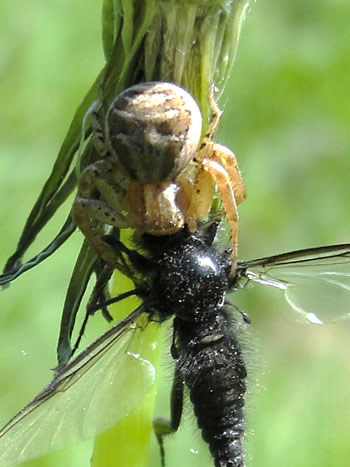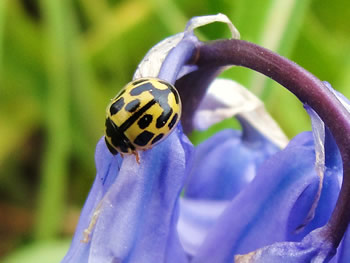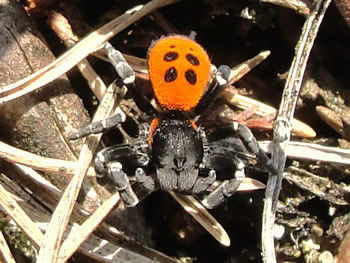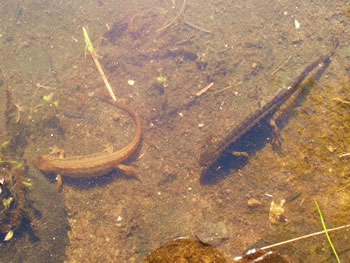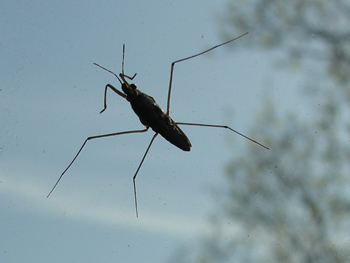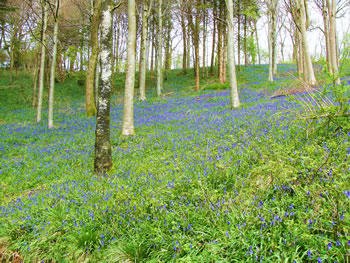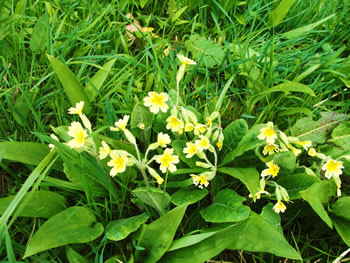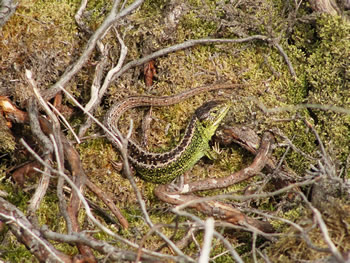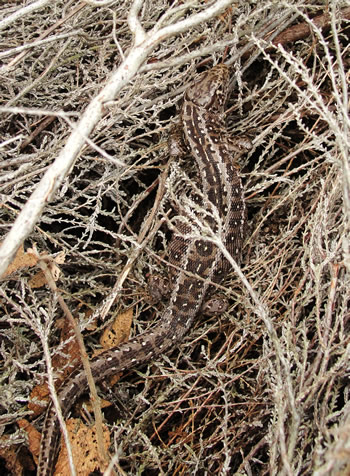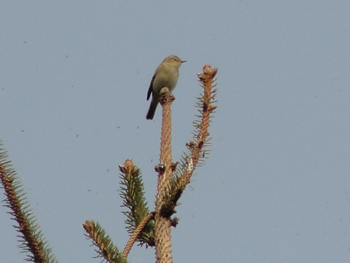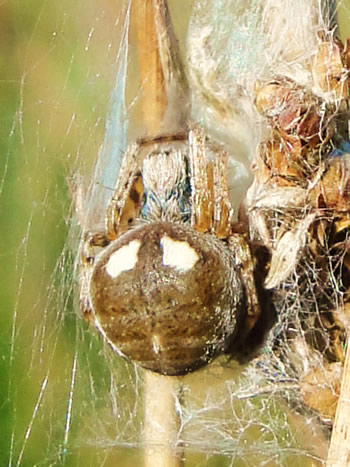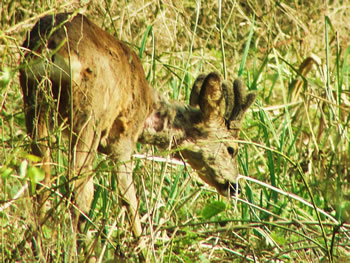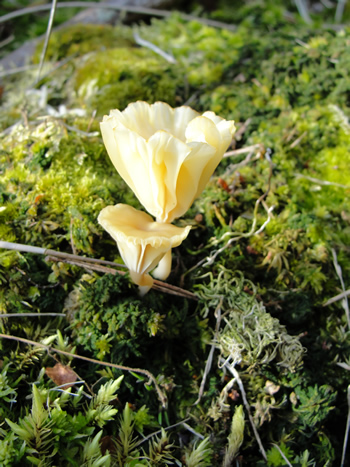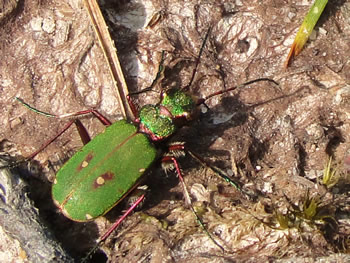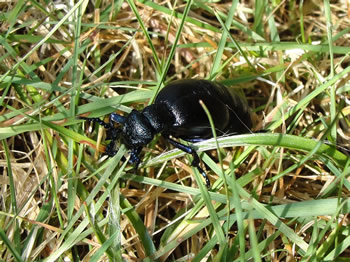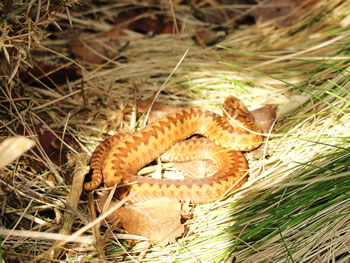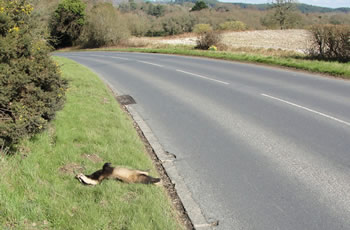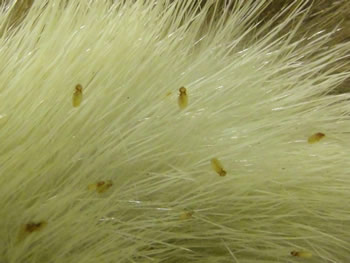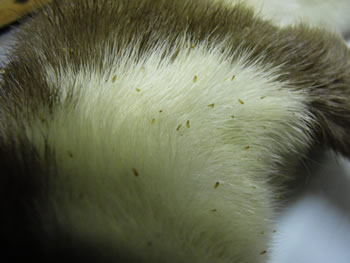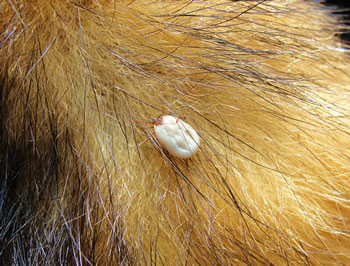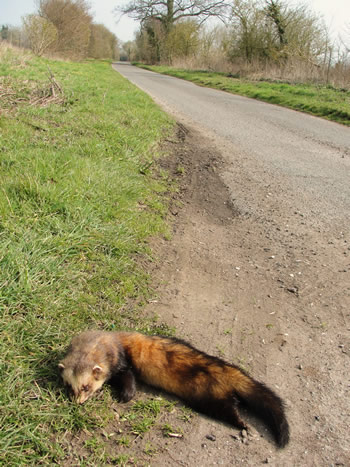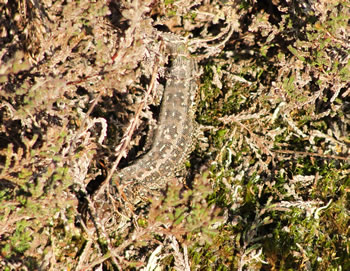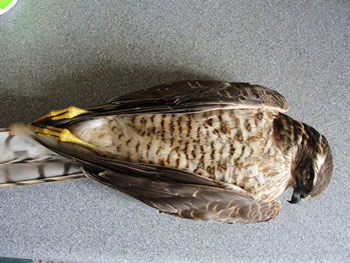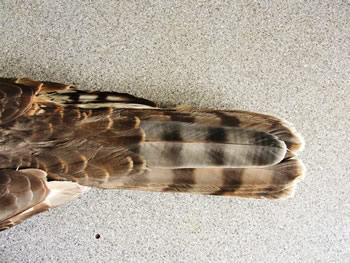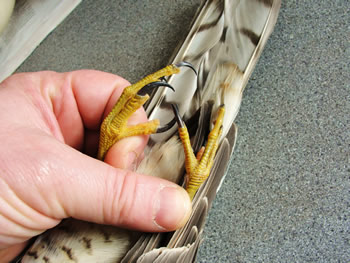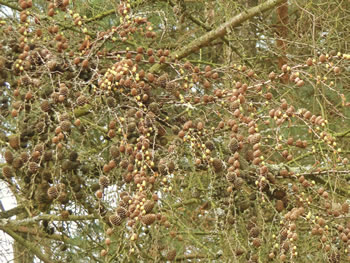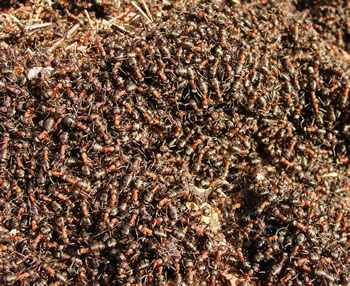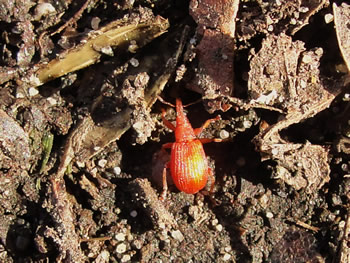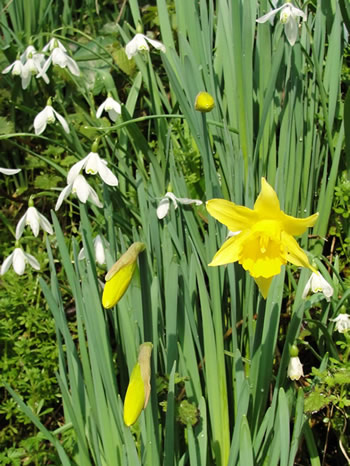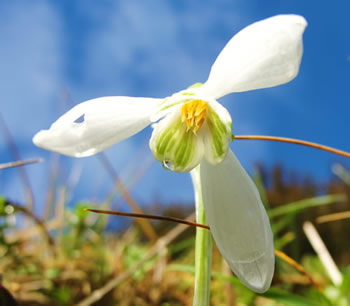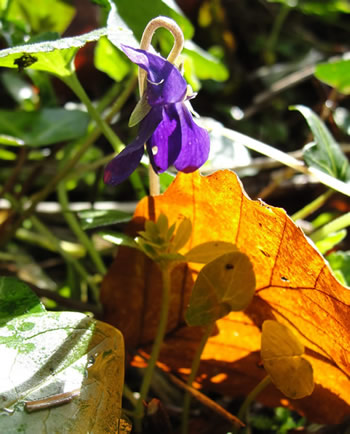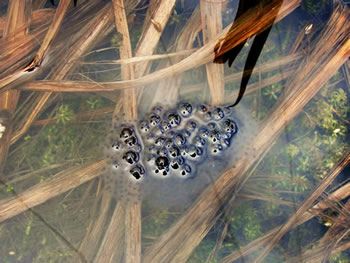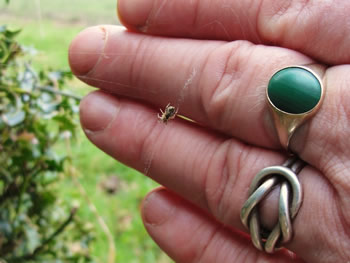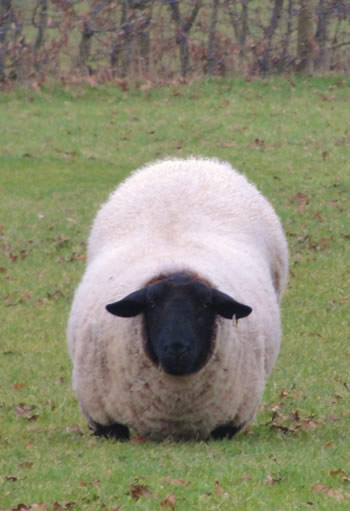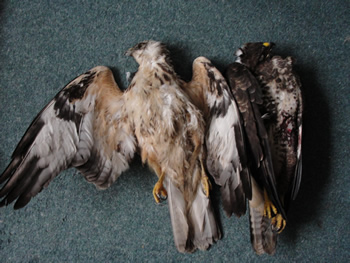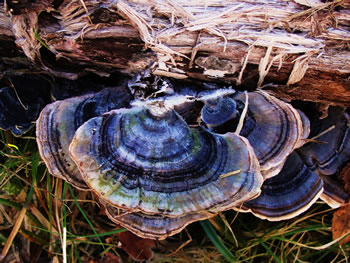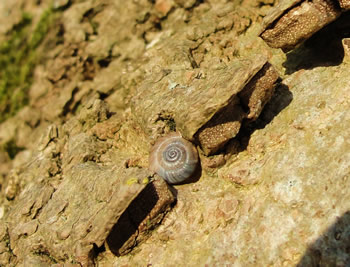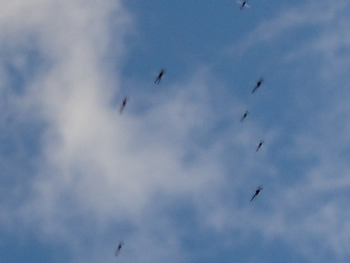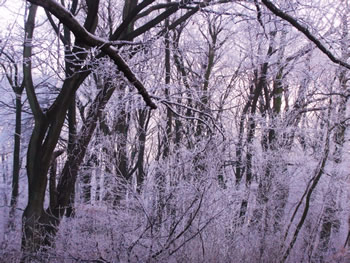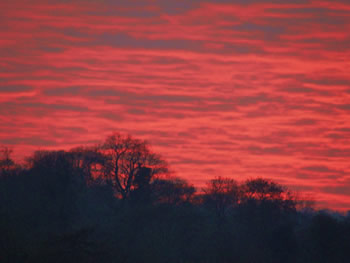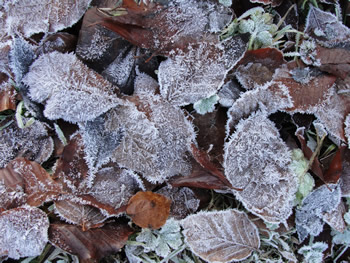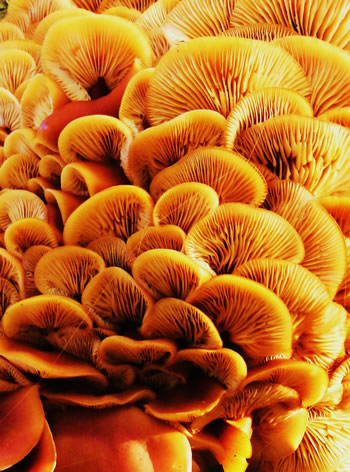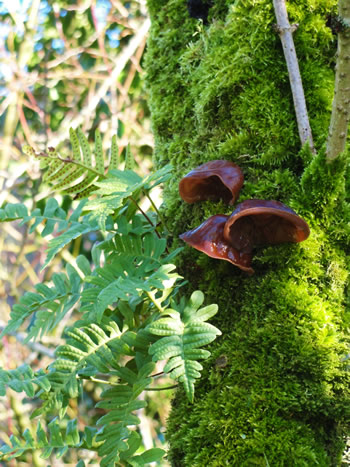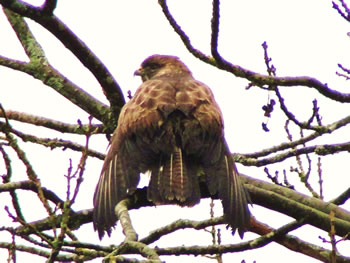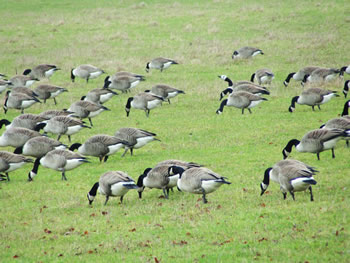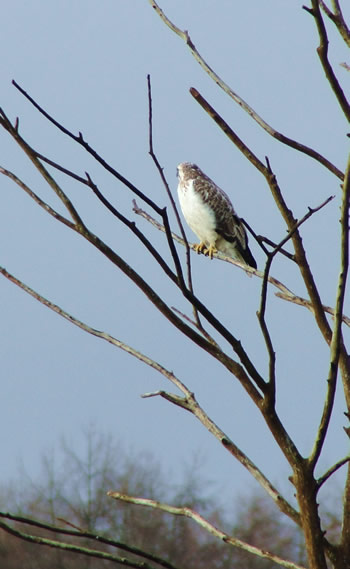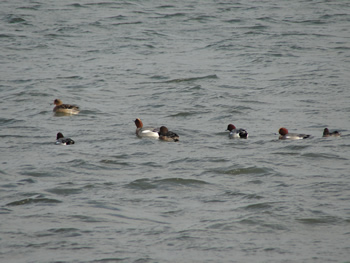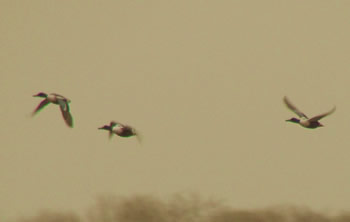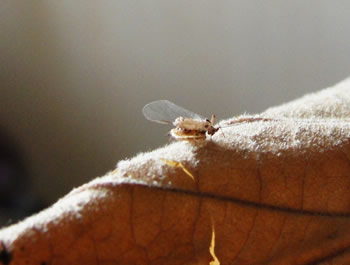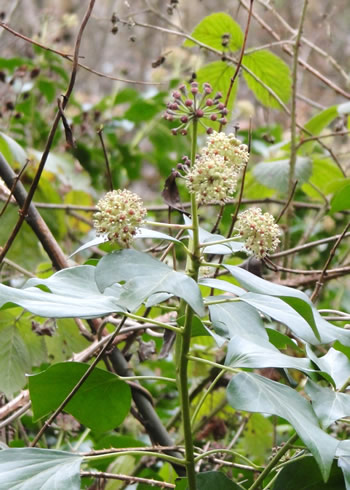Some Heathland Animals
The family of small land snails under several different orders and sub orders
comprise of thousands of species. Most live in warmer climates but here in the UK
we have many small species. they can be seen in both dry and damp habitats but more
often in ancient woodland on tree trunks or on limestone walls and cliffs.When they
climb down a vertical surface the shell l turns down and the weight helps the
mollusk to speedily descend.
The local sika deer are in herds of either all stag, or females with calves.the
stags antlers are now almost fully grown but still covered in the growing velvet of
furry skin with blood vessels underneath.Only a few weeks before the rut starts at
the end of September will the velvet be shed before the bone hardens ready for the
rut.
The male nightjar awaits dusk by looking very much like the gorse branch he is sat
on. The birds are summer migrants from Africa and are night time hunters of small
insects.
Reptile Rapters
Another road killed buzzard was picked up by myself just outside Bournemouth. It was a small light coloured male.On opening up its stomach, I found lots of lizards.Two gravid female common lizards, one gave birth whilst inside the stomach, two slow worms, one juvenile.Here they are in situ.
Here they are displayed out.
Grasshoppers are well known for their colour varieties within certain species especially pink.The common meadow grasshopper (Chorthippus parallelus)is the most likely in the UK,to show shades of pink or purple. I found this specimen near heathland Near Thomas Hardy’s cottage .
Colourful Lepidoptera
Young Roe deer are moving around .Young bucks only in their first or second year are pushed out of areas as the mature bucks re insert their dominance and territories, forcing the young animals to wonder away from their mothers. It is a hard time for them and they turn up in all kinds of locations.the antlers of this buck are just growing as single beams.
The scarlet tiger moth is scarce now in Britain but every year they can be found in certain of rough flowery meadows such as Martin down nation nature reserve on the Hants Dorset border . They are day flying like most brightly coloured day flying moths and they advertise the fact that they are poisonous to eat.
The caterpillar of the mullein moth(shargacucullia verbasci)is a handsome sight on such an equally handsome a plant.Another similar species the Striped lychnis(S.lychnitis) can be confused especially in regards to the larvae.The moth is less common and can only be found on chalk downland in southern England.I do think this is the latter species, at Martin down nature reserve.
Mullein plants are common especially the white, and the black is less so, but the large flowered , or moth mullein is quite rare. Here a huge swave of it thrives surrounded by Dorset heathland.The plants were also covered with moth larvae.
Vole in the Hole
Voles are very common little rodents and are one of the vital prey species for many animals.Bank voles and short tailed voles are very numerous in the habitats where they live, providing food for owls, kestrels, buzzards,stoats and weasels, badgers, herons, polecats and real cats.Here a baby bank vole peers from its nest that was under a flat piece of wood on Bournemouth cliff top.
Pond Life
A walk around a tiny heathland area can throw up all kinds of interesting fauna and flora,especially the former . sitting by a murky pond I watched palmate newts (Lissotriton helveticus)basking and catching invertebrates that had fallen onto the waters surface.This particular male was eating shed skin.It may have been it’s own slough or that of another newt.
By it were many diving beetles of the family (dytiscidae) of which in Britain we have just over a hundred species. this a female Acilius sulcatus. one of two similar species to be found in bogs and heathland pools.they also like to bask in the sun, often coming out of the water and onto rocks and overhanging branches. I think they waft pheromones into the air in the hope of attracting a flying male.The females can fly also like most diving beetles.They need to to colonize new ponds as often ponds dry up so they need to move on. the males look slightly different in most species.
Behind the pond a small herd of sika deer needed to drink. They came nearer to the pond but saw me and uttered their alarm calls before leaping away.They looked stunning in their red summer coats.
Heathland Fire
Thursday was another time of disaster on one of Dorset’s heathland. About sixty five percent of the North side of Upton heath went up in flames destroying this rare and natural habitat for many species of animals. The flames were put out just yards from peoples property’s as firefighters did another fine job. The fire burned fast and deep and it will take up to twenty years for the site to fully recover. It is not natural for wild fires to sweep through any environment within the U.K. Fires are started by people either directly or by discarded cigarettes or dumped barbecue remains or by abandoned fires. It is so sad that despite all the education in schools about the problem, there are still nasty teenagers usually who think it is a good laugh to see it all happen.
I personally think that the authorities must do more to find out who is responsible.
A male sand lizard peers from his burrow into a world of blackness. Unless he is caught he will perish.
Many reptiles need to be captured and released elsewhere. Here is a bucket full of common lizards and a few sand lizards and one slow worm.It took two of us most of the day to collect these.
The survival of these rare and endangered lizards is in the hands of humans.those animals caught out in the open within a sea of burntness will succumb. It will take many days to quarter the whole area picking up stragglers.This is a close up of a female sand lizard just captured.
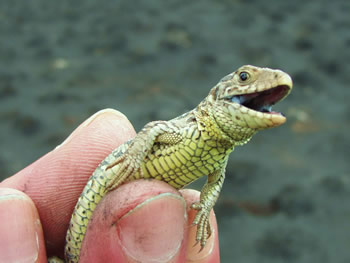
A young otter has been killed on the road. It is a dog cub. It was found in an area where a small stream had dried up due to the drought.Otters that hunt around small streams will have to search further afield if they are to survive especially if it is a female with cubs in tow.They often resort to eating rats and rabbits or waterfowl if fish are in short supply.Frogs and snakes are also taken.The animals may have to cross many roads with the inevitable happening. Here is the cub along side a big male polecat for size comparison.
Odds and Sods
I took some six spot ladybird larvae home with me to control aphids on my capsicum plants. They did a great job and they developed into adults. Here is an adult just after emergence from its pupae on the kitchen net curtain.
Conopid flies are related to fruit flies and picture winged flies, many are parasitic in other insects and as adults they are important pollinators of flowers.The species here is Myopa, one of several species of natural pasture land.This one was in the center of Bournemouth on an Osteospermum flower.
Many species of ladybird have bred several times this season already, and there are many stages of development. Here are some four day old hatchlings on the underside of a sweet chestnut leaf. I believe they are Harlequin ladybird.
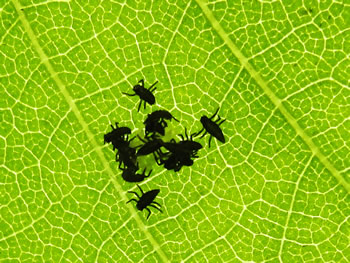
Larvae Antics
Many of the country hedges are covered in silken tents with large patches of munched vegetation. Many people are at a loss as to what it is.This year, like the last two years have been very good for the Spindle ermine moth,Yponomeuta cagnagella.
The moth is a micro moth and is white with little black spots, like most ermine moths, so called for their markings and colour resemble a stoat in its northern winter coat called ermine.Here are the caterpillars in their silken tents.
The puss moth, cerura vinula is a striking beast in its larval form. these are hatch-lings on sallow, or goat willow.As they mature, they develop purple colouring and can emit strands from the tail appendages.
Oh Deer an Adder Ladybird
Whilst driving through Hartland moor in Purbeck, I came across this juvenile adder that had just been hit by a car. It was striking the air.
The striped ladybird Neomysia oblongoguttata, is rare and was found on heathland in Dorset. They are very distinctive.
The Harlequin ladybird Harmonia axyridis, on the other hand is none native and is an all round predator of not just aphids but also other ladybird larvae hence concerns for our native species.they sport more variation than other ladybird species.It arrived from south east Asia as a biological control for other pest species and escaped and is now our most common beetle.
Most species of deer have now given birth and this sika hind was reluctant to flee as her calf was hiding in the heather,instead of staying put, it leapt up to join her and they both ran off onto the moor.
At this time of year deer are very vulnerable to road vehicles and especially dogs.dog owners must keep their animals under control at all times and not allow them to wonder off.
The Birds and the Bees
The Tawney mining bee is busy making little burrows in the lawn. They are harmless and very common.
I saw and heard the lovely male tree pipit singing on a dead branch on a piece of heathland.
The brown tailed moth is having a very good season and the bramble bushes are covered with tents and there are thousands of larvae walking around searching for other food plants as they have exhausted the supply.these caterpillars are generally harmless but some people may get allergic reactions to the their hairs if touched. It is wrong for local authorities to kill them with sprays as many birds and reptiles eat them and need them. some animals rely on them especially the adult moth.Here a caterpillar is on sea pink.
Crabs and Fairies
This is the time of Year when little pretty moths such as this longhorn moth ,Adela reamurella, flutter up and down on the foliage of oak trees or around the leaf litter on the ground where the larvae feeds.There are many of these Pyralid moths and they belong to the large group of micro moths.The males of this species and several similar species sport long antenna.
The similar female awaits a male.
A smaller species, Micropterix calthella, group together and eat pollen from sedges such as pendulous sedge in woodlands or take pollen from flowers such as this Early purple orchid,orchis maculata.
ST marks flies,Biblo marci, swarm in masses in warm and humid weather, much to the annoyance of people but they are completely harmless. The hover around with legs dangling, and the larvae feed in the rotting humus of the ground breaking down fungi and leaf litter.This one has been captured by a crab spider ,xisticus species.
Colour in Nature
The Thrift, or sea pink are now flowering along Bournemouth cliffs and the tiny pollen beetle Ischnomera coerulea is abundant inside them as well as the seaside daisy. They are vivid blue.
Bluebells are at their peak and this ladybird Calvia quatuordecimpunctata feeds on plant lice.
The ladybird spider, Eresus cinnabarinus male eratically blunders across the heathland looking for the female counterpart which will be safely in her earthen burrow.These spiders are amazing in regards to their life cycle . They are long lived and at about five years old the burrow living gray male turns red and hunts for the larger female.He then dies after mating.The female dies after her eggs have hatched and the spider-lings eat her, giving them the best start in life. The spiders live in burrows with small webs attached to the ground and surrounding heather or moss and take mainly beetles.They were on the verge of extinction in the Uk but now small colonies exist in special areas.
Sika deer are now dropping their antlers, many have already done so and are growing new ones.This animal was a yearling killed by road traffic, and ended up as bait by an infra red trigger camera.
Fortunately the peregrine falcons have returned to Bournemouth College tower to nest. Here is the female awaiting the tiercel’s return .
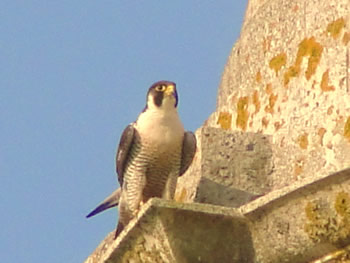
Spring Flowers and Pond Life
Newts are breeding now and in a Bournemouth urban pond, smooth newts, (Lissotritan vulgaris)are busy mating and egg laying.These are also called common newts but over the last twenty or thirty years they have become less common.In some areas especially where the water is acid, such as on heathland, the species is replaces by palmate newts.The female is the lighter coloured individual and the male has a crest, as most newt species do.
Also on the pond surface will be common pond skaters,Gerris lacustris gerridae, these creatures are true bugs as they do not have jaws but sucking mouth-parts.They live on the surface of the water skimming about feeding on drowned invertebrates. They also fly and locate ponds by reflecting light. sometimes they misjudge and fall for a car windscreen or bonnet, as this specimen had.
The bluebells are just cumming into flower in the higher woodlands on the chalk downs
And I came across these false oxlips, in the same area. These plants are hybrids between the common primrose, primula vulgaris, and the
cowslip primula veris
Wonderful Lizards
Lizards are very active. The green lizards, Lacerta biliniata,have emerged from hibernation, and wall lizards Podarcis muralis are busy feeding and mating. The males are acquiring their breeding colours.Here is a photo of both species side by side for comparison. The male green lizard is much smaller than usual,and he is with a male wall lizard.
Now is the time when migrant birds are to be seen. the raptors come from the East and often are very low over the countryside and towns.this red kite was lucky to be alive as it dived several times in a busy road to check out some road kill rabbit.
A sand lizard Lacerta agilis, is basking and is half green already, on a piece of heathland.
And a female is very camouflaged in the heather near by.
Spring Happenings
A male chiffchaff singing from the top of a conifer is a nice sound to hear at this time of year. They will sing up until mid summer, then again before they depart in the early autumn.These small birds unlike some of the other warblers have not started to stay the winter.
Many spider species die at the onset of winter, others live on and hibernate to emerge in spring to live another summertime. This particular species does just that. Agalenatea redii. It is a small orb weaver and can be found amongst reeds and rushes in damp meadows and on heathland.
Roe deer are still growing their antlers under a velvet skin.Most will not be hard until the end of the month or beginning of May. This animal had a wound on its neck and claw marks on its rump. It may have had a narrow escape from a hunting animal.
Now is the time to look out for spring migrants.Small warblers are here and many more will follow. Swallows usually can be seen around the first week in April, followed closely by house and sand martins.raptors have started to arrive and I saw a red kite yesterday at Knowlton church in East Dorset.
Early Animals
The recent weather has been so good, but a lack of rain is not so good for all kinds of animals and plants that rely on dampness at this time of year,however, many types of fungi seem to be fruiting and this unidentified specimen, was in damp moss in a bog at Arne nature reserve, Purbeck.
Times are good for beetles such as this common tiger beetle.It can be found on heathland and other sandy places, flying and landing when disturbed.
Oil beetles are uncommon and there are two similar species in England. They appear during springtime to mate and lay eggs. The female lays an egg under the base leaves of flowering plants, usually yellow composites and the larvae after hatching, climb the stalk of the plant and then wait among the inner area of the flower for a bumble bee to come along, they then hitch a ride to its nest and eat its pollen supplies.
Adders have been out of hibernation for weeks and are enjoying the warmth. today the temperature was eighteen degrees and under the heather on the dark sandy soil, temps were twenty four degrees.This specimen was a juvenile, hence its orange colouring.
Road Deaths and Parasites
This week I found another eight dead badgers on the local roads.
also four dead polecats and three dead stoats.All of them were carrying external parasites in the form of lice.The lice the badgers and polecats were carrying were the same species or they at least looked exactly the same, but the stoats were different.
the above pic shows the badger lice.
These are the smaller stoat lice, a close up, with a further away shot below.
One of the polecats was carrying lots of caster bean ticks.
One large male polecat, dead on a Wiltshire road.
the main reason as to why so many mustelids get killed on the roads at this time of year is because it is the mating season for most species, except the badger.most male mustelids travel far and wide in search of females in heat.the badger benefits from having a delayed implantation of the blastocyst which means that they can mate at any time of year, especially in July or October, but the young will not be born until late January of February.Other mammals also use this method such as roe deer, seals and pine martins.
Hawk that Rarely Eats Sparrows
Great. My first sand lizard, Lacerta agilis of the year,. The males emerge first, as they need to get their sexual apparatus in working order and suss out a small territory before the females emerge over a week later. It will take a while before he attains his breeding colours after his first moult. It will be at least another five weeks before he reaches breeding condition.
This is a juvenile male sparrow hawk. It looks like the female until its second year, however it is smaller.most species of raptors have sexual dimorphism. The females are larger and browner. more body means more eggs and more brooding cover. it pays for the male to be small, faster, taking more abundant smaller prey and bring it back to the nest for the female while she incubates.
Here you can see the male plumage , as the smaller grey feather protruding over the brown.Throughout the early summer, all the tail feathers will change like this, and the breast pattern will be russet orang bars. they are already changing.
Here you can see the feet. most raptors have yellow coloured scales on the legs and feet. the feet of birds of prey specialised for catching birds, are different to those that specialise in catching mammals or reptiles. the sparrow hawk is a bird feeder. they rarely take mammals or reptiles but its larger relative the goshawk takes both birds and mammals.Most raptor species though are opportunistic and given the chance, will take other forms of prey at some time.Kestrels are generally insect, and small mammal feeders but will often take small birds and reptiles. barn owls generally take voles but will take small birds and amphibians.
this specimen flew into a window. It often happens to this species as they chase small birds that fly into them out of confusion, or the hawk can see an opposite area of sky through another window and flies through hoping to ambush prey on the other side.Most small birds that hit windows are being chased by sparrow hawks.
Second Signs of Spring
I was looking for primroses in the usual habitat, and there were only a few in flower, but this little specimen caught my eye as it nestled in a tiny crevice within an old church wall.
The leaves of most conifer trees are evergreen, but the larch drops its short bunches , and looks dead through the winter. It now unfurls them amidst the dry cones of last year.
A true sign that spring has sprung for me are the huge masses of wood ants above their nest, waking up and sorting things out. They smother an area in their thousands basking in the sun and will do this for several days before getting to work rebuilding their mound. There is another species of wood ant that does not make a visible mound but instead builds it underground, the species is rare but still survives in the Bournemouth district.
Another sign of spring is this tiny , pretty little weevil Apion miniatum. It is orange red and is associated with docks and sorrels.
The First Signs of Spring
A drive along a West Dorset Lane provided a splendid scene of wild daffodills and snowdrops.
Also are early violets and primroses,dandelions, dogs mercury and periwinkle.
Frogs started to spawn during last weeks full moon, and will carry on doing so for another two weeks.This is the spawn of common frogs, toads spawn later and the spawn is produced in long ribbons rather than clumps like this.
Mushy Toad
I found this dead toad covered in fungus. It would have died on the damp forest floor after being trodden on, possibly by a deer and the fungus quickly enveloped the animal.
Big Fat Sheep
This is the gorse jelly fungus,Tremella mesenterica and it is common on gorse from Autumn to summer.sometimes there can be large amounts but usually only one or two lower branches in the vacinity are fruiting.
Now spring is springing, the snowdrops have been in flower for a fortnight, and many daffodills are flowering, hazel catkins are swinging from slim twigs and pussy willow flowers beckon the early bee.I came across a tiny spider, a male cyclosa conica at a field margin.
And a big fat sheep.
Roadkill Horrors
I have driven in my car, seventy miles of Dorset,west Hampshire and south Wiltshire roads a few days ago, and was appalled to count these road victim animals. Ten foxes, twelve badgers, three polecats, one weasel, one Tawney owl,four buzzards,two sika deer, two roe, two domestic cats,two hares,one mink, along with many other road mashes that were unidentifiable. How sad. very sad.Many of the badgers will be females that have just given birth, and the cubs will starve to death in their setts.What is even more sad is the fact that vehicle drivers do not even remove them from the road. what a wicked waste of lives.what can be done to help stop the carnage?
Migrant Buzzards
I have noticed that there are many of the light phase common buzzards, and they may be just winter visitors that have come down from the north along with the cold weather. Last week I noticed three within a couple miles of each other.The overall population of buzzards have been double in some areas, and mainly it is these light individuals that are the anomaly.i even found a road victim specimen, shown here along side a normal coloured individual.These birds are around Dorset, Hants and wiltshire.
This is a top side view.
Winter Happenings
This bracket fungus was a lovely shade of blue, sometimes it is prolonged cold weather or frost that turns old growth colourful.
This is a lapidiary snail.They are flattened ventraly and are the size of a penny. They live mainly in chalky districts. This one is hibernating in a cleft of bark on the west side of a tree.
Winter gnats swarm above my head in a field.
Winter Delight
The intense cold makes pretty hoar frost in frost pockets such as this beech woodland in the Stroud Valley in Gloucestershire. The frost was at the top of the highest of trees.
Also photogenic sunsets
And frosted leaves.
Fungi fruits in the brief mild times, such as this bracket on an old beech.
Again I have found an odd looking road killed polecat. They are reminiscent of Martins with their cream or yellow bibs and they also have white or yellow feet like stoats. I know that in some domestic ferret breeding there are these colour morphs, yet it is possible for these variations to crop up in wild populations but especially if they have been tainted with ferret genes.I have found eight polecats within the last three weeks. More will be killed on our roads as the breeding season gets underway next month. They must be vey common for so many to get killed on the roads.
After the Rain
With the mild wet weather prevailing,many fungi are fruiting. All it needs is warm wet weather just like autumn, or even spring for some species. Fungi grows very quickly and the mycellium which are the roots that live under the soil, or wood grow at a phenomenal rate. The fungi then fruits to spread its spores, and the fruit is the part we see.Here ear fungus grows along side a pollypody fern and moss on a dead elder tree.
Another buzzard, a common buzzard, dries its wings after all night rainfall. There are over fifty species of buzzards world wide and many of them are very similar .
Huge flocks of Canada geese graze the meadows. Here the individual with its raised head has a lack of dark on its face. These geese are not native here but from Canada as the name suggests. They are not much of a pest unless you are a farmer with crops, and in parks they can become too numerous and they then make a lot of noise and mess.They are good for predators though and foxes and large cats feed on many.
The Harsh Winter
While near Fordingbridge in Hampshire, I managed to snap this white fronted buzzard. Common buzzards are renowned for their variably, marked plumage and specimens with white are quite common, yet such full white fronts as this one are rare. There are records of all white specimens, and the rough legged buzzard,a similar species that visits us in the winter look very pale like this. The tarsi are feathered down to the feet in the rough leg, but here it is hard to tell from that alone, but another photograph of it preening shows the dark inner wing patch , and the dark eye stripe, along with the light tail suggest that it a rough legged.
The little sea at Studland has been full of wildfowl this winter including the common wigeon, a flock duck that can be seen grazing along riverbanks and fields, they make a whistling squeak and like most duck species, the drake is more colourful than the drab duck.
Also there were these Shovelers in flight.
This aphid has been taken over by an Entomorphic fungi. Even in cold weather, there are small micro climates where tiny insects such as this can thrive along with its host fungi.
Ivy (hedera helix) flowers in the winter is a very important source of pollen for feeding bees and hoverflies when there is nothing else for them to feed on. Additionally ivy is very important as cover for nesting birds and a whole host of invertebrate life, and it additionally it protects the host tree. It is pointless therefore to remove it, and doing so especially with well established plants will cause fungi to enter the tree trunk and inevitably kill it.

